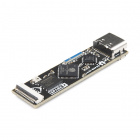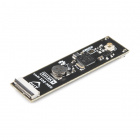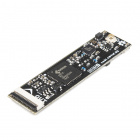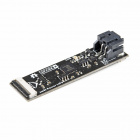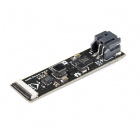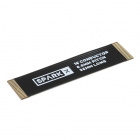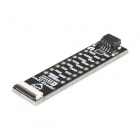Contributors:
 PaulZC
PaulZC Introduction
Our RedBoards are great. But don't they sometimes seem a little BIG?!
Enter smôl, a new range of boards which are both small in size and small on current draw. It's a smôl world!
Above is a GNSS receiver, a satellite transceiver, and an ESP32 with WiFi and 16MB storage, all running for 100 days off a 400mAh battery. 😲
When we designed our ARGOS Satellite Transceiver Shield - ARTIC R2, we knew that people would want to use it for applications like wildlife tracking, ocean buoys, environmental monitoring or transferring emergency medical information. But what if you want to develop something much smaller? Say, a small dart for whale tracking, or a small backpack for avian tracking. Or you just need your battery to last for months. smôl is designed to meet those needs.
The stack in the above photo is a complete ARTIC R2 satellite tracker capable of transmitting 2.5m accuracy position fixes five times per day to the ARGOS satellite network (ARGOS provides global coverage, including the oceans and the polar regions) using a 400mAh battery for over 100 days!
The smôl family of boards includes:
Processor Boards
SPX-18619
Our RedBoards are great. But don't they sometimes seem a little **_BIG_**?!
Enter **smôl**, a new range of boards which a…
Retired
GNSS (GPS) Boards
SPX-18623
Our RedBoards are great. But don't they sometimes seem a little **_BIG_**?!
Enter **smôl**, a new range of boards which a…
Retired
Satellite Communication Boards
SPX-18618
Our RedBoards are great. But don't they sometimes seem a little **_BIG_**?!
Enter **smôl**, a new range of boards which a…
Retired
Power Boards
SPX-18622
Our RedBoards are great. But don't they sometimes seem a little **_BIG_**?!
Enter **smôl**, a new range of boards which a…
SPX-18621
Our RedBoards are great. But don't they sometimes seem a little **_BIG_**?!
Enter **smôl**, a new range of boards which a…
Essentials
CAB-18731
This is the 36mm 16-way 0.5mm-pitch Flexible Printed Circuit used to interconnect smôl boards.
***
_**smôl** is an ec…
Retired
Accessories
SPX-18620
Our RedBoards are great. But don't they sometimes seem a little **_BIG_**?!
Enter **smôl**, a new range of boards which a…
Skill Level - Competent: We think smôl is brilliant and we will be releasing more smôl boards over the coming months. We have plans for: environmental monitoring, IMU, RFID, radio and GNSS peripheral boards; plus additional processor boards. However, we recognize that the smôl format is - intentionally - very small and that the FPC connections can be a little bit
fiddly until you get used to working with them. So, we're recommending smôl for those with
Level 3 (Competent) DIY and Electrical Prototyping skills:
- Whether it's for assembling a kit, hacking an enclosure, or creating your own parts; the DIY skill is all about knowing how to use tools and the techniques associated with them.
- If it requires power, you need to know how much, what all the pins do, and how to hook it up. You may need to reference datasheets, schematics, and know the ins and outs of electronics.

